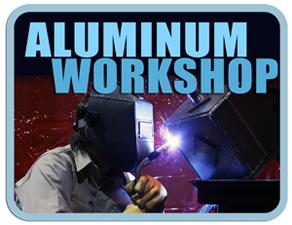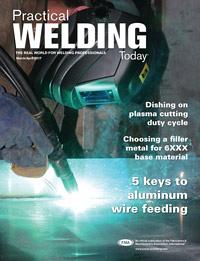President
- FMA
- The Fabricator
- FABTECH
- Canadian Metalworking
Categories
- Additive Manufacturing
- Aluminum Welding
- Arc Welding
- Assembly and Joining
- Automation and Robotics
- Bending and Forming
- Consumables
- Cutting and Weld Prep
- Electric Vehicles
- En Español
- Finishing
- Hydroforming
- Laser Cutting
- Laser Welding
- Machining
- Manufacturing Software
- Materials Handling
- Metals/Materials
- Oxyfuel Cutting
- Plasma Cutting
- Power Tools
- Punching and Other Holemaking
- Roll Forming
- Safety
- Sawing
- Shearing
- Shop Management
- Testing and Measuring
- Tube and Pipe Fabrication
- Tube and Pipe Production
- Waterjet Cutting
Industry Directory
Webcasts
Podcasts
FAB 40
Advertise
Subscribe
Account Login
Search
Aluminum Workshop: The truth about welding aluminum castings
- By Frank Armao
- March 23, 2017
- Article
- Aluminum Welding
Q: A group of friends and I were talking the other day. Some people said that all aluminum castings are weldable. Others took the extreme opposite position and said that aluminum castings usually aren’t weldable. What’s the truth?
A: The short answer is that, yes, most aluminum castings are readily weldable. However, in addressing the question of casting weldability, we must consider two aspects. First, is the composition of the casting weldable? The most common aluminum casting alloys are the heat-treatable 3XX.0 series, such as 356.0, 357.0, and 319.0. These are aluminum-silicon-magnesium (AlSiMg) alloys, but some, 319.0, for example, also contain copper (Cu). The good news is that these alloys are all readily weldable with 4043 serving as the correct filler.
The next most common casting alloys are the AlMg 5XX.0 alloys, such as 535.0. These are not heat-treatable but are readily weldable using 5356 filler. However, the family of 7XX.0 aluminum-zinc (AlZn) casting alloys, also heat-treatable, are considerably more difficult to weld. In fact, some are not weldable. We will try to discuss them in a subsequent column.
Another important characteristic that must be considered is how the casting was made. There are many casting processes, including green sand casting, investment casting, permanent mold casting, and die casting, just to name a few. Sand castings, investment castings, and permanent mold castings are usually very weldable because molten aluminum is cast into a mold that is a relatively poor thermal conductor, so the casting solidifies slowly. This means that any dissolved gases in the molten aluminum have a chance to percolate out. However, die castings are very different. In this process, the molten aluminum is pressure-injected into a water-cooled steel mold. Since the casting cools very quickly, the dissolved gases can’t escape and tend to form gas pockets in the casting. Usually you’ll find these gas pockets as you are welding, and there isn’t much you can do about it besides grind out the pocket and repair-weld it.
So how do you know if the casting you need is a die casting? First, the surface finish of die castings is much smoother than other castings. Second, it’s a die casting if you see somewhere between four and 10 round marks, called ejector pin marks, that are about 1/8 in. in diameter on the inner and outer surfaces. When the steel casting die opens, the ejector pins extend and pop the casting out of the die. If you don’t see any ejector pin marks, you don’t have a die casting.
I am certainly not saying that die castings can’t be welded. They certainly can, but they require a bit more caution than other types of castings.
About the Author

Frank Armao
Aluminum Consulting Inc.
440-479-0239
About the Publication
Related Companies
subscribe now

The Welder, formerly known as Practical Welding Today, is a showcase of the real people who make the products we use and work with every day. This magazine has served the welding community in North America well for more than 20 years.
start your free subscription- Stay connected from anywhere

Easily access valuable industry resources now with full access to the digital edition of The Fabricator.

Easily access valuable industry resources now with full access to the digital edition of The Welder.

Easily access valuable industry resources now with full access to the digital edition of The Tube and Pipe Journal.
- Podcasting
- Podcast:
- The Fabricator Podcast
- Published:
- 04/16/2024
- Running Time:
- 63:29
In this episode of The Fabricator Podcast, Caleb Chamberlain, co-founder and CEO of OSH Cut, discusses his company’s...
- Trending Articles
Sheffield Forgemasters makes global leap in welding technology

Welding student from Utah to represent the U.S. at WorldSkills 2024

Lincoln Electric announces executive appointments

Lincoln Electric acquires RedViking

Engine-driven welding machines include integrated air compressors

- Industry Events
16th Annual Safety Conference
- April 30 - May 1, 2024
- Elgin,
Pipe and Tube Conference
- May 21 - 22, 2024
- Omaha, NE
World-Class Roll Forming Workshop
- June 5 - 6, 2024
- Louisville, KY
Advanced Laser Application Workshop
- June 25 - 27, 2024
- Novi, MI



























